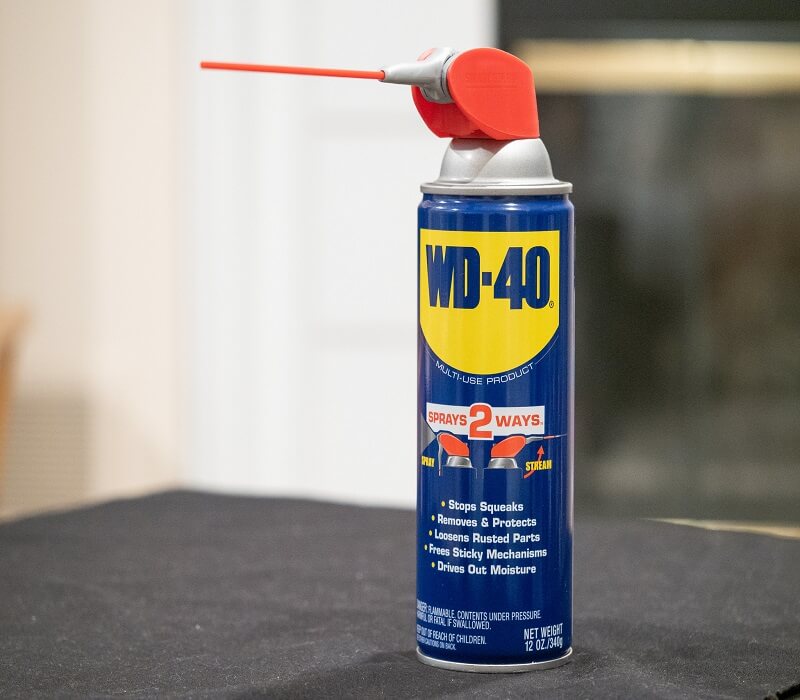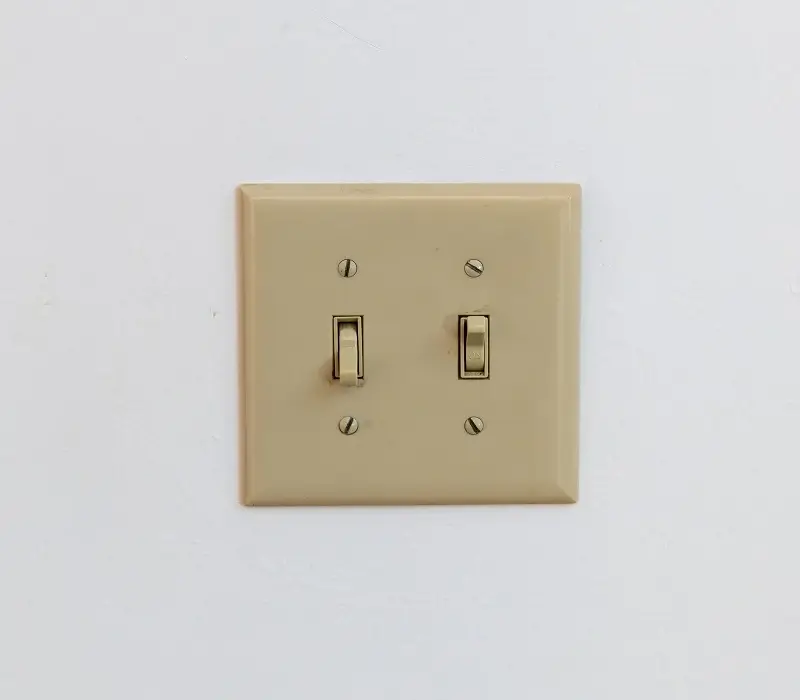
WD-40 is a petroleum-based product that can help you remove a wide range of stains. It’s so effective that we include it in several cleaning guides. However, it, unfortunately, leaves behind residue and does carry its own scent. Now I want to tell you how to Remove WD40.
Other than polycarbonate and clear polystyrene, WD-40 is generally safe for most surfaces. However, it will emit an odor that can cause nasal and some other respiratory issues when inhaled at higher concentrations. To put it another way, you must deal with the product’s residue as soon as possible.
The good news is that getting rid of the WD40 isn’t that hard. In fact, most of you already have what it takes to remove WD-40. Without further ado, here’s what you should do.
Table of Contents
How to Remove WD40 Residue
Dishwashing Liquid
Mix some dishwashing liquid such as Dawn with hot water, soak a cloth into the solution, and dab the residue. In some cases, the residue won’t be removed but rather softened.
In this case, pick a plastic scraper and scrap it off the surface. Then wash the surface with clean water to remove any leftover residue.
Baking soda
If Dawn didn’t completely remove the WD40 and you want something more powerful, baking soda is the best candidate.
Apply baking soda to the WD40 residue and allow it to sit for one hour. Then, wipe it with soapy water and rinse the whole surface with clean water.
Remark: If you’re dealing with WD-40 residue on a painted wall, I highly recommend using this method.
Use WD-40 (Again)
Although it may seem paradoxical, you can actually remove WD-40 by using WD-40. The thing is that when this product dries, it leaves a waxy layer behind (a thin adhering hydrophobic). And when you reapply the product to the coating, it will soften and become easier to remove.
Once you reapply the product, simply wipe away the WD-40 coating with dish soap and water and rinse with hot water. This method works best when dealing with WD40 on glass.
Goo Gone
Goo Gone is another excellent cleaner for removing WD-40 from hard surfaces.
- Apply Goo Gone to the affected area and let it sit for 5 to 10 minutes.
- Wipe it away.
- Wash the surface with hot soapy water.
- Repeat if necessary.
As you can see, using Goo Gone is quite simple to use.
How to Get Rid of the WD40 Smell
Baking soda
When it comes to neutralizing bad odors, baking soda is your best bet. Unlike most commercial air fresheners, baking soda doesn’t mask odors but rather absorbs them.
What’s also cool about it is its ease of use. Simply sprinkle the baking soda over the odorous spot and let it do its job.
Then, wipe the spot with a damp sponge or vacuum it up if it’s on a carpet or sofa. However, when using baking soda on carpets, avoid applying too much since it will be a pain to remove.
Remark: If the odor is too strong, you may need to let the baking soda sit for several hours.
Related: How to Remove Baking Soda from Carpet Like a Pro
Another natural, versatile household cleaner that you can use to neutralize odors is white vinegar. Fill a spray bottle with distilled white vinegar. Then, spray vinegar over the odorous area and let the solution sit to eliminate the odor.
The cool thing about white vinegar is that you don’t need to rinse it. This ingredient indeed carries its own scent, but it will disappear within a short period of time.
If you cannot stomach the scent of vinegar and want something more pleasant, we recommend using lemon juice.
Lemon juice’s odor-neutralizing properties are as good as white vinegar.
Dishwashing Liquid
Mix a few drops of dishwashing liquid, such as Dawn, in lukewarm water. Dip a sponge or clean cloth into the solution and wipe the oily or odorous spot.
Then, rinse with clean water to remove any soapy residue and repeat until you get everything off the surface. We highly recommend this method for folks looking to clean WD40 residue off floor tiles.
Essential oil
Essential oils have plenty of benefits that one can take advantage of, including the ability to remove bad smells. Here’s how to properly use it to get rid of the WD-40 odor.
Fill a spray bottle with two cups of water. Add between 20 to 25 of your favorite essential oil. Then, give the bottle a good shake and spray the smelly spot.
Additional Tips
- Before you apply the tips mentioned above to a sofa, make sure to check your couch’s tag. Keep in mind that each sofa has its own cleaning method. For example, you can’t use a solution based on the water on a sofa with an S tag.
- If you want to speed up the process of removing the WD-40 smell, make sure your workspace has enough ventilation. In fact, with appropriate ventilation, the WD40 odor may disappear on its own after 30 minutes. Otherwise, it will linger for hours.
- If you’ve never used one of the products mentioned above, try it first on an inconspicuous part of the surface you wish to clean. If the product shows no adverse reaction, you can then treat a larger area.
Conclusion
We hope you found value in this guide. We’d highly appreciate it if you could leave us a comment below telling us which method has worked for you best.
Also, if you want similar cleaning guides that can help you become a professional cleaner, you can subscribe to our newsletter, where we share exclusive cleaning tips.
Can you wash off WD-40?
Yes, WD-40 can be washed off with soap and water. It is important to wash it off completely, especially if it is applied on a surface that may come in contact with food, such as kitchen appliances or utensils.
How do you remove WD-40 oil?
To remove WD-40 oil, absorb the excess oil with a cloth or paper towel, sprinkle baking soda, cornstarch, or talcum powder on the affected area, let it sit for 30 minutes, gently scrub the area with a soft-bristled brush, wipe away the powder, apply dish soap if needed, rinse with clean water, and dry with a clean cloth. If the oil has penetrated deep into the material, professional cleaning or replacement may be necessary.
Is WD-40 easy to remove?
It depends on the surface and the amount of WD-40 that has been applied. WD-40 can be easy to remove with soap and water or with an appropriate cleaning solution if it hasn’t penetrated deep into the material. However, if it has been applied in large quantities or has been left on for a long time, it may require more effort and time to remove.
Does WD-40 fully evaporate?
No, WD-40 does not fully evaporate. It leaves a thin film of lubricant behind that provides long-lasting protection against rust and corrosion. However, if WD-40 is applied in excess or on a surface that is exposed to dirt and dust, it may attract and accumulate more dirt, which can cause problems over time.
Does WD-40 eventually dry out?
Yes, WD-40 can eventually dry out, especially if it has been exposed to air or if it has been applied in excess. As the solvent in WD-40 evaporates, the lubricant can become thicker and more viscous, which can reduce its effectiveness.
How long does WD-40 stay on a surface?
The length of time that WD-40 stays on a surface can depend on several factors, such as the type of surface, the amount of WD-40 applied, and the environmental conditions. Generally, WD-40 is designed to provide long-lasting protection against rust and corrosion, so it can stay on a surface for several weeks or even months.
We're an affiliate
We hope you love the products we recommend! Just so you know, CleanyHome.com is a participant in the Amazon Services LLC Associates Program, an affiliate advertising program designed to provide a means for sites to earn advertising fees by linking to Amazon.com.

![How to Get Rid of Spiders in the Basement [9 Effective Tips]](https://supercleanworldall.com/wp-content/uploads/2021/07/depositphotos_125531742-stock-illustration-the-pattern-with-spiders.jpg)
